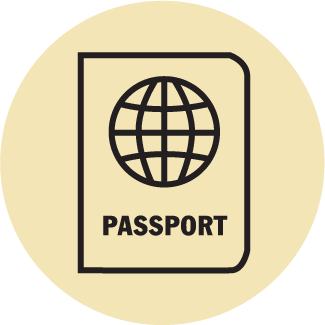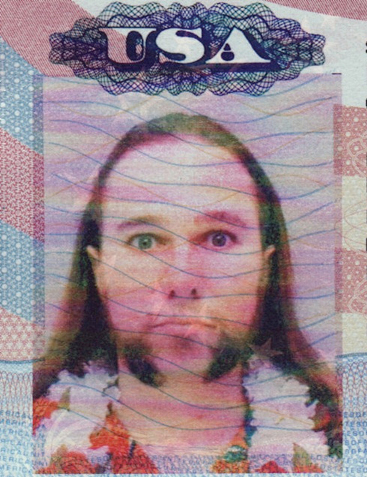
PASSPORTS AND VISAS
In order to leave this country, you’ll need a passport. Some countries also require visas for entrance or to work, study, or stick around a while. This is step one to get you off your ass and into the world. We’ve been there and have the rashes to prove it, so here is what you need to get started.



 PASSPORTS
PASSPORTS
TRAVEL.STATE.GOV
This US Department of State website is something our government has actually done right. It has well-organized, complete, and official information regarding passports, visas, embassies, and guidelines for visiting every country on the planet. You should visit this website early and often when planning any international trip.
PASSPORT
Your ticket to the world—any US citizen can get a passport. Here’s how:
1. Dig up your proof of citizenship (birth certificate, previous passport, or certificate of citizenship) and your driver’s license or state ID.
2. Make a copy, front and back, of both forms of ID.
3. Get one passport picture at any drug-store with a photo department in five minutes for about $10. Take off your glasses; don’t wear a hat or bling; and don’t smile. No duck faces, and keep your shirt on.
4. Go to Travel.state.gov/passport/ and fill out the DS-11 form online. Print it out.
5. Submit your application at a post office or municipal government office.
Routine processing for a passport takes four to six weeks and costs $110 (plus $25 for first-timers). Expedited processing is two to four weeks and will run you an extra $60. If you’re traveling within two weeks or need to get a visa within four, it will cost extra, but you can schedule an appointment at one of the twenty-five government passport agencies, and they’ll hook you up with a little blue book faster.
PASSPORT CARD
A passport card can be used to travel to Mexico, Canada, or the Caribbean by land or sea (not air!). The application process is about the same as for a passport book, but it fits in your wallet and is $80 cheaper. It’s handy if you live near a border and cross it often, but for the type of travel you should be doing, you’ll need a passport book.
HOW TO HANDLE YOUR PASSPORT
 Don’t lose it! Take plenty of precautions. Don’t walk around with your passport (unless the country you’re in requires you to have it at all times). Instead, carry a copy of your passport and visa (if there is one) in your wallet, stash one in your bag, and give one to a travel buddy. Also, e-mail a copy of your passport and visas to yourself in case you lose all your shit and need to prove to Uncle Sam at an embassy that you are family.
Don’t lose it! Take plenty of precautions. Don’t walk around with your passport (unless the country you’re in requires you to have it at all times). Instead, carry a copy of your passport and visa (if there is one) in your wallet, stash one in your bag, and give one to a travel buddy. Also, e-mail a copy of your passport and visas to yourself in case you lose all your shit and need to prove to Uncle Sam at an embassy that you are family.
 If you do lose it … US passports let you move rather easily around most of the world (good news), so the black market for them is huge (bad news). If it gets lost or stolen, go to the nearest US embassy. They will wipe your tears and get you a replacement ASAP.
If you do lose it … US passports let you move rather easily around most of the world (good news), so the black market for them is huge (bad news). If it gets lost or stolen, go to the nearest US embassy. They will wipe your tears and get you a replacement ASAP.
 VISAS
VISAS
A visa is a document or stamp placed in your passport that acts as an endorsement to enter a country. Many countries require a visa for entrance, and most do for work, study, or extended stays. Some you can get at the border (or when you arrive), and others you need to obtain in advance. Specifications and requirements can vary widely—for most places in Europe you don’t even need one. If you’re looking for a visa to trek around places not in the EU, however, you’ll need to take a look at their visa requirements. Once again, Travel.state.gov will let you know all the specifics for entering a country, as well as where to go to get a visa, if needed. Plan ahead—some visas take weeks to get, and sometimes, if you don’t have one, you’ll be denied boarding on your flight or will be turned away at the border.
